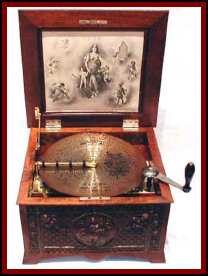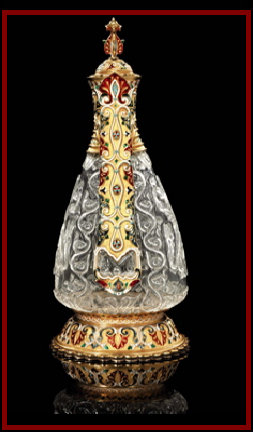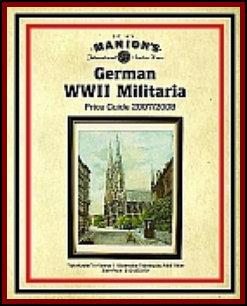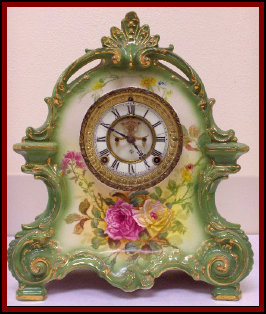












Thank you for your continued support and readership. Please insure to forward this Newsletter to your friends and neighbors. If you no longer wish to receive our emails regarding the update of this page, please send us an email to info@nova-antiques.com with the subject line "OPT OUT"
NOVA-Antiques.com does not run, manage or operate any of the flea markets, auction houses or estate sale companies advertised on this page. The NOVA-Antiques Newsletter is published for the exclusive use, enjoyment and convenience of our readers and subscribers. Any questions regarding the flea markets, auction houses and estate sale companies should be directed to the appropriate owner, promoter or manager.
© All rights reserved. Do not copy or duplicate without the expressed written permission of Northern Virginia Antiques & Collectibles.










A Brief History of Regina Music Box
According to the Musical Box Society International, a music box is an instrument which plays music
by the plucking of teeth on a tuned steel comb. Most commonly found in a cabinet, usually made of wood, which contains a disc or cylinder
music box movement. Music boxes became very popular in the 1700’s in both Europe and America. However one of the
most popular music boxes from the Regina Company did not come into existence in the United States until around 1892.
Dumb Mikey and His Too Tall Mule
Since Mikey is no longer in the antique flea market business he decided to move out to a farm. On this farm he has a hard working mule. The only problem is that the mule hates to go back into its stall because its ears
would brush up against the top of the entrance and the mule would then proceed to go nuts and kick everything. So brilliant
as Mikey is he decides that what he will do is cut out the top of the entrance for more clearance.



Islamic Decanter Up For Auction Again
After an error in identification by an auction house in England, a 1000 year old crystal decanter will
be auctioned off again on October 7, 2008. The decanter, which was previously dated as being from the 1800’s, is actually an
Islamic artifact dating between the 10th and 11th Centuries. It is one of only seven known to exist. The confusion in
the dating came from the fact that a lot of faked carved crystal items were made in the late 1800’s and through the early 1900’s. The original auction for the decanter brought in almost $400,000 but the sale was cancelled after the dating error was discovered. The decanter is now expected to bring in more than $5.4 million at a Christie’s auction.
New Book – Manion's German WWII Militaria Price Guide
The long recognized leader in the sale of military collectibles, Manion’s International
Auction House, Inc. is releasing their first realized price guide in over a decade. “The name Manion’s is synonymous with militaria,”
said company executive Jody Tucker. “We are pleased to be able to provide collectors and dealers with the information they need to
make informed decisions related to the commerce of this hobby.”

Upcoming Antique Shows & Flea Markets
NOVA-Antiques.com provides the most comprehensive antiques show and flea market calendar
for the Mid Atlantic region.
Click here to view the most current antiques and collectibles shows calendar . . . > > >
Click here to view our flea
market directory and review pages . . . > > >
Atlantique City Antiques & Collectibles Show
The month of October brings the return of the Atlantique City Antiques and Collectibles
Show to the gaming city with a boardwalk. The show, which will be held on Saturday and Sunday, October 18 & 19, 2008 will
host an exhibit that first made its debut at the Republican National Convention in Denver, Colorado this month. The exhibit
titled, “The American Presidential Experience,” and features political memorabilia, is collaboration by both the show organizers and
Worthpoint.com. In addition to the exhibition, the Atlantic City Convention Center will be feature over 400 dealers selling
all manner of quality antiques and collectibles. This show is billed as one of the largest in the nation and attracts more than
10,000 visitors from around the world.



The price guide will provide realized price information for WWII German items sold on the militaria auction website www.manions.com over
a 15 month period covering all of 2007 and a portion of 2008. “We sold well over 100,000 items during this time,” said Tucker.
“Obviously it proved impossible to include data for all of these items.” The guide will present final value information for
nearly 2000 WWII German items in period, what was essentially the first half of Manion’s WWII German catalog. This data was condensed
from over 20,000 German catalog items. Some of the items included are: edged weapons, uniforms, headgear, field gear, and insignia.
Gustav Brachhausen of the Polyphon Company came to America and to establish the company. In the beginning the Regina music boxes
were beautiful boxes made in America but the inner workings were really from the Polyphon Company. By 1894, the boxes were pretty
much an American product with combs and motors that were being produced in Rahway, New Jersey. What made Regina music boxes
special, besides their crisp and rich sound was the fact that the music disks were interchangeable with other Regina boxes. Even after the phonograph was invented, Regina continued to make certain types of music boxes and continued production until about
1920. Although most of us know the name Regina, we mostly associate the name with vacuum cleaners because they later morphed
into that business.
Like the Regina Company above, the Ansonia Clock Company is an American company that has its roots in where else
but Ansonia, Connecticut. Originally started as Ansonia Brass Company, the owner, Anson C. Phelps, soon realized that since
clock movements were made of brass why not go into the manufacturing of clocks. Ansonia was one of the major makers of clocks
in the 1800’s and produced millions between the mid-1800’s and the late 1920’s. Many of their clocks are beautifully decorated
and superiorly designed shelf clocks. Most of their clocks are marked with the Ansonia name are easily recognizable at antique
shops and auctions. However, if you find a clock marked “Ansonia, Conn” it was probably made prior to the late 1870’s.

As he is working his neighbor stops by and asks Mikey what he is doing. So Mikey tells him and the neighbor suggests to him
that he could save a lot of time by just taking a shovel and digging down the entrance a little bit. Mikey looks at in that
bewildered way of his and says, “that would be fine if his feet were too long, but the problem is that his ears are too long.”
In the late 1870’s the Ansonia Clock Company moved to a building on Broadway in New York City, which was originally the Ansonia Hotel
and owned by an heir and stock holder in the company. Their clocks made after the move are marked “New York.” Disaster
struck soon after they moved to New York and a fire consumed their factory. However, they rebuilt and were back in business
by the early 1880’s. Ansonia Clock Company continued producing clocks until the late 1920’s after which they sold their machinery
to Russia. The rights to name the Ansonia Clocks brand was sold to a company in Lynwood, Washington but they stopped producing
the brand in December of 2006. The Ansonia building later became apartments and is listed in the National Register of Historic
places.
Manion’s 2007-2008 WWII German Realized Price guide will provide high, low, and average data for both final value and condition. A
full-color image is also provided for each listing. “This is our new management’s first attempt at a project like this,” said
Tucker. “We learned a lot about the publishing process during the endeavor, and look forward to incorporating feedback from collectors
in producing subsequent editions.”
The guide is slated for release during the 2008 Military Antiques Extravaganza (MAX) show at thePittsburgh Expo Mart, in Monroe, Pennsylvania, October 3 – 4, 2008. Copies will be available at the event, and copies will be available
over the Internet.